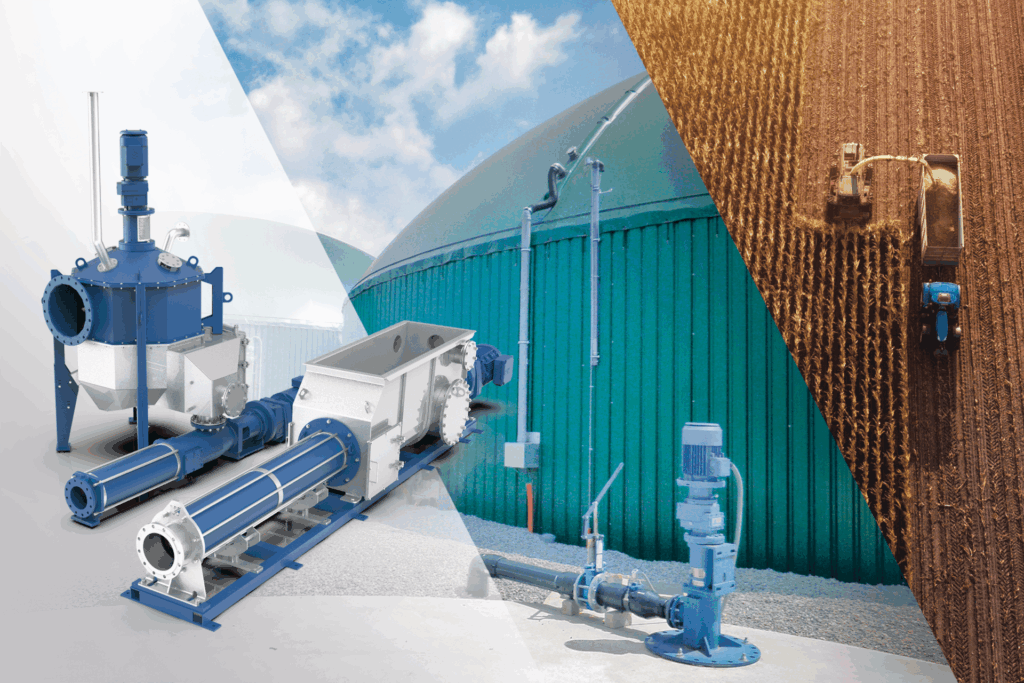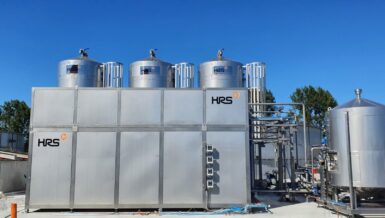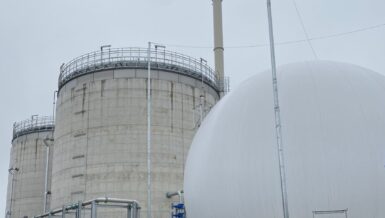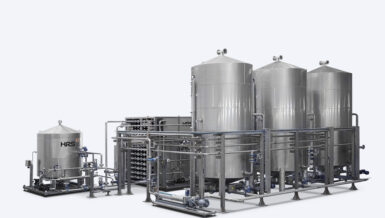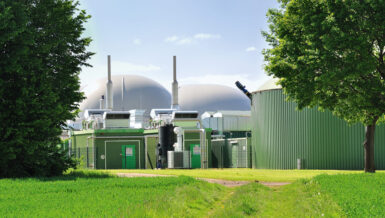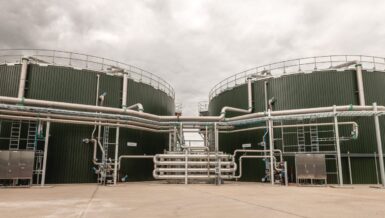Around 10% of the world’s primary energy currently comes from biogas(1). Used at scale, it is estimated that biogas could reduce global greenhouse gas emissions by 18 to 20%(2). Biogas also offers a second advantage: it supports a circular economy by reusing everyday waste from diverse sources to generate new and valuable products such as electricity and heat. As a result, biogas is – and will continue to be – crucial in enabling countries to hit their decarbonization and recycling targets.
From biowaste to energy
The return on investment from biogas is predicated on the type and amount of waste used as feedstock, the specifics of the plant processes, the end-use application, and market conditions. However, the principle of biogas production is relatively easy to understand. Organic waste such as animal manure, food scraps, wastewater biosolids, grease, and other organic by-products are used as the feedstock. This waste is fed into an airtight anaerobic digester to which fluids are added. Kept at a temperature of around 30-45°C, the waste is stirred continuously for two to four weeks. These controlled conditions encourage microorganisms to break it down. The resulting biogas is a mixture of 45-75% methane (depending on the feedstock), carbon dioxide, and a tiny percentage of other gases(3).
Biogas can be used to generate electricity and heat. After further purification processes, it can also be turned into a renewable natural gas (RNG) called biomethane, which can be used as vehicle fuel or injected directly into gas grids(4). In addition, the digested material can be employed as an organic fertilizer or to create other products, including animal bedding, building material, and plant pots(5). Biogas also reduces environmental impacts: farms that process their animal waste in anaerobic digesters reduce methane emissions and prevent nitrogen from polluting local fields and water courses(6).
The market for biogas
According to the International Energy Agency (IEA), the biogas sector grew worldwide by approximately 19% between 2017 and 2022. The predicted growth rate for 2023-2028 is 32%(7). Technological improvements, efficiency gains, and the widespread availability of adequate feedstock have been critical to this steady growth in both Europe and North America in recent decades. In many cases, government support has also been central. As a result, more than 60% of the world’s current biogas production capacity is in Europe and North America(8). IEA research further suggests that one-third of the total growth potential for biogas will be in the “advanced economies”, half of which will be in North America and around 30% in Europe(9).
The European Union (EU) 2022 REPowerEU Plan, which aims to reduce the EU’s dependence on fossil fuels, includes updated targets for biomethane production:
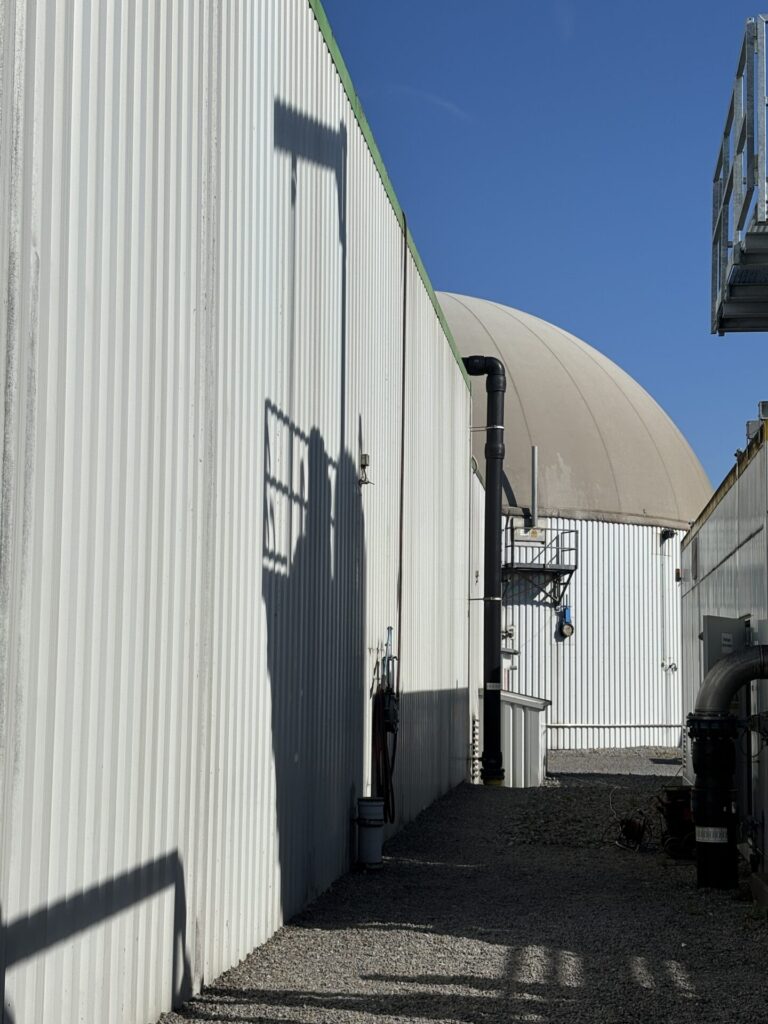
Boosting sustainable biomethane production to 35 bcm [billion cubic meters] by 2030 is a cost-efficient path to achieving our ambition to reduce natural gas imports. To increase the capacity of biogas production in the EU and promote its conversion into biomethane, the estimated investment needs to amount to EUR 37 billion over the period(10).
Current European biomethane production is somewhere between four and five bcm(11). In terms of production measured in gigawatt hours (GWh), the European Biogas Association (EBA) reported that the biggest producers in 2021 were Germany (12,753 GWh), the United Kingdom (6,183 GWh), Denmark (5,683 GWh), France (4,337 GWh), the Netherlands (2,374 GWh) and Italy (2,246 GWh)(12). However, by 2022, France was reportedly just behind Germany and ahead of Denmark and the UK for biomethane production(13). By April 2023, the EBA reported that the continent had 1,322 verified “biomethane-producing facilities: 30% more than in 2021(14). To reach the 35 bcm target, the EBA calculates it would require tens of billions of euros in investment, 4,000 medium-sized anaerobic digester units, and 1,000 large plants(15).
In the U.S., there are more than 2,400 biogas sites across 50 states, encompassing hundreds of farms, wastewater plants, landfills, and other facilities. Around 70% of the feedstock comes from municipal waste and around 20% from agriculture(16). The U.S. has the potential to create an estimated further 15,000 new biogas plants, with the commensurate benefits of creating enough energy and heat for millions of homes, besides creating thousands of jobs and increasing energy security(17).
Biogas also has potential in other regions. China is already a prolific user of biogas digesters. Many are used domestically, predominantly in rural areas(18). The country also has an estimated 100,000 biogas plants(19). There is also considerable potential for biogas growth in India, Indonesia, Malaysia, Thailand, and various countries across Asia. India’s Prime Minister Narendra Modi has recently reiterated his commitment to delivering 5,000 biogas plants in the country by 2030(20).
However, there is a caveat. According to the IEA, biogas “is concentrated in countries with specific support programs for this fuel.”(21) While there is potential for the expansion of biogas in numerous countries, many of them lack either governmental support or technological expertise (or both).
In South America, biomethane uptake is mixed: Chile and Argentina do not yet have a clear development framework, but Brazil(22), where the government is an active supporter of renewable fuels and biomethane, has concrete targets and strong public support. Indeed, biogas development in Brazil could outpace that of more advanced countries. Its theoretical potential is 121 bcm, largely from agricultural waste and other residues, particularly from the sugar industry. In the short term, around 30% is realistically available, but at 36 bcm this is equivalent to the whole of Europe’s forecast biogas growth in 2030.
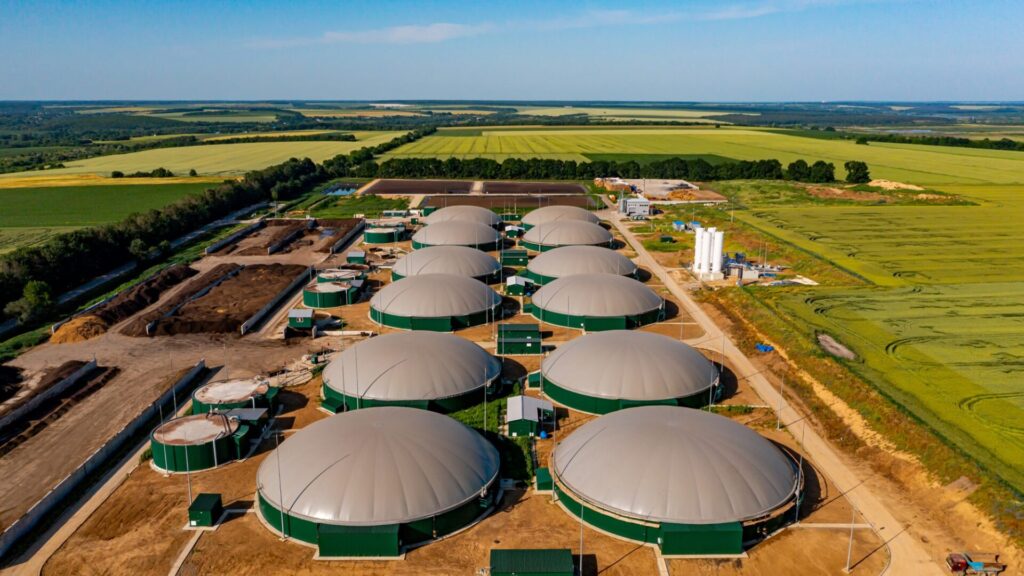
Optimizing biogas generation
Expertise is vital to fulfilling the economic and environmental potential of biogas, no matter where in the world the plant is built. Within the technical framework of biogas and biomethane production, pump technology is critical to ensure reliable and cost-efficient operations.
Pumps are used to transport viscous media, so the technology needs to be matched to the type of substrate and the specific biogas plant parameters. Substrate pumps also need to be sufficiently robust to operate continuously and transport highly viscous substrates over long distances. Pumps are also used during the separation of solid and liquid phases. This can involve the movement of high dry matter (DS) content and requires specially designed pumps and modules that prevent long fibres from becoming caught and creating blockages in the piping system. Crucially, pumps also control the feedstock mixing to obtain the correct consistency before it is introduced into the fermenter. Proper pre-mixing of the solid and liquid feedstock reduces the mixing activity in the fermenter, which will lead to significant energy savings. Wangen Pumps, a German pump manufacturer and part of the Atlas Copco Group, has a wealth of experience in building and installing pumping solutions for the biogas industry worldwide. Its efficient and reliable technology enables critical operations in thousands of biogas plants and facilities across Europe, America, China, Japan, India, and Africa. The company estimates that it has supplied more than 50,000 pumps to the biogas sector worldwide over the past 25 years, including some of the largest plants in China and the largest biogas plant in the United States of America, located in Oregon.
Conclusion
Countries and businesses are already in the process of reducing carbon emissions and hitting carbon-neutral targets, but there is still much to be done. In recent years, much of the progress in biogas and biomethane plant technology has been in Europe, North America, and China, where supportive development frameworks are in place. While the markets in these regions continue to grow, the potential for expansion in emerging economies highlights that the biogas sector has significant worldwide expansion possibilities.
In-depth technical understanding is vital to optimize production and deliver cutting-edge processes for renewable energy generation. The transition to a more sustainable future will be underpinned by the application of appropriate, state-of-the-art technology and engineering expertise. As global biogas and biomethane production continues to grow, the demand for the required technology and systems will rise accordingly, and innovation will follow, including industrial pumps.

- IEA: https://www.iea.org/reports/outlook-for-biogas-and-biomethane-prospects-for-organic-growth/an-introduction-to-biogas-and-biomethane
- World Biogas Association: https://www.worldbiogasassociation.org/wp-content/uploads/2018/07/WBA-Climate-Change-Biogas-factsheet-2.pdf
- IEA, An introduction to biogas and biomethane: https://www.iea.org/reports/outlook-for-biogas-and-biomethane-prospects-for-organic-growth/an-introduction-to-biogas-and-biomethane
- European Biogas Association (EBA): https://www.europeanbiogas.eu/avoided-emissions-from-biogas-and-biomethane-can-lead-to-a-negative-carbon-footprint/
- EPA: https://www.epa.gov/agstar/how-does-anaerobic-digestion-work
- WWF: https://www.worldwildlife.org/blogs/sustainability-works/posts/is-biogas-a-green-energy-source
- IEA, Renewables 20213. Analysis and Forecast to 2028, p. 140: https://iea.blob.core.windows.net/assets/96d66a8b-d502-476b-ba94-54ffda84cf72/Renewables_2023.pdf
- IEA: https://www.iea.org/reports/outlook-for-biogas-and-biomethane-prospects-for-organic-growth/the-outlook-for-biogas-and-biomethane-to-2040
- IEA: https://www.iea.org/reports/outlook-for-biogas-and-biomethane-prospects-for-organic-growth/sustainable-supply-potential-and-costs
- EU: https://eur-lex.europa.eu/legal-content/EN/TXT/?uri=COM%3A2022%3A230%3AFIN&qid=1653033742483
- Based on the fact that European biomethane production grew 20% in 2021, to reach more than 3.5 bcm that year, and the European Biogas Association estimated that, ‘an even bigger increase is expected for 2022.’: https://www.europeanbiogas.eu/strongnew-record-for-biomethane-production-in-europebrshows-eba-gie-biomethane-map-2022-2023-strong/
- European Biogas Association: https://www.europeanbiogas.eu/strongnew-record-for-biomethane-production-in-europebrshows-eba-gie-biomethane-map-2022-2023-strong/
- CNG: https://www.cng-mobility.ch/en/beitrag/record-7-billion-cubic-metres-of-biogas/
- EBA: https://www.europeanbiogas.eu/biomethane-map-2022-2023/
- EBA: https://www.europeanbiogas.eu/wp-content/uploads/2022/04/REPowerEU-with-biomethane-FINAL-1.pdf
- CNG: https://www.cng-mobility.ch/en/beitrag/record-7-billion-cubic-metres-of-biogas/
- American Biogas Council: https://americanbiogascouncil.org/resources/why-biogas/ & National Grid: https://www.nationalgrid.com/stories/energy-explained/what-is-biogas
- Waste Management 30 (2010), pp. 549-550, Anaerobic digestion: An intriguing long history in China, p. 551. National Grid: https://www.nationalgrid.com/stories/energy-explained/what-is-biogas
- IEA: https://www.ieabioenergy.com/blog/publications/a-perspective-on-the-state-of-the-biogas-industry-from-selected-member-countries-of-iea-bioenergy-task-37/ & IEA https://www.iea.org/reports/outlook-for-biogas-and-biomethane-prospects-for-organic-growth/the-outlook-for-biogas-and-biomethane-to-2040
- PMIndia: https://www.pmindia.gov.in/en/news_updates/pm-inaugurates-india-energy-week-2024/
- IEA: https://www.iea.org/reports/outlook-for-biogas-and-biomethane-prospects-for-organic-growth/the-outlook-for-biogas-and-biomethane-to-2040
- World Biogas Association, Market Report: Brazil: https://www.worldbiogasassociation.org/market-report-brazil/



